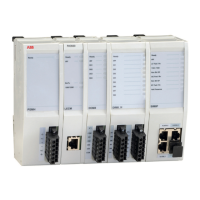First condition for detection of fault passage is based on evaluation simultaneously the
phase angles of three ratios of changes in phase current phasors (fundamental
frequency) due to the earth fault:
FPI_AtoB =
angle
I
I
A
B
∆
∆
1
1
GUID-D515DEC4-C291-4B9B-8F72-923551F553A5 V1 EN (Equation 23)
FPI_BtoC =
angle
I
I
B
C
∆
∆
1
1
GUID-5D1B6E80-64DB-4DF1-BA3C-C031DA278C57 V1 EN (Equation 24)
FPI_CtoA =
angle
I
I
C
A
∆
∆
1
1
GUID-B3F99130-AEB9-4E9C-A0CF-3BFDE75A3CA2 V1 EN (Equation 25)
where
ΔI
A
= I
A
(t
FLT
) - I
A
(t
PRE_FLT
) = change of phase A current phasor due to earth fault
ΔI
B
= I
B
(t
FLT
) – I
B
(t
PRE_FLT
) = change of phase B current phasor due to earth fault
Δ
I
C
= I
C
(t
FLT
) – I
C
(t
PRE_FLT
) = change of phase C current phasor due to earth fault
Actual implementation uses CPS calculation. Accumulation of phasors is started
when the presence of earth fault in the network is confirmed and accumulation of
phasors is reset when fault condition is over, and after Reset Delay Time has elapsed.
The indication of fault passage is declared when:
• the maximum phase angle is above setting Angle Sector AND
• the minimum phase angle is below setting -Angle Sector
Additionally, the absolute values of maximum and minimum phase angles of
Equations 23 - 25 in the faulted feeder should be equal. Their difference, that is, the
phase angle offset (= maximum – minimum phase angle) must not exceed setting
threshold Angle Offset Sector.
1MRS757488 H Section 6
Commissioning
RIO600 155
Installation and Commissioning Manual

